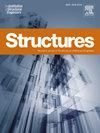An integrated experimental and computational framework for design and analysis of WAAM fabricated structural elements
IF 4.3
2区 工程技术
Q1 ENGINEERING, CIVIL
引用次数: 0
Abstract
The current research work presents an integrated experimental and computational framework for characterizing and predicting the mechanical behavior of Wire Arc Additive Manufacturing (WAAM)-produced materials. Tensile samples extracted from a WAAM-fabricated cylindrical tube were tested to evaluate stress-strain and failure behavior. The mechanical properties of WAAM components were compared with those of conventionally manufactured counterparts and benchmarked against industry standards such as EN 1993–1–1. A computational framework based on the Gurson-Tvergaard-Needleman (GTN) model was developed to predict load-displacement curves, local strain, and failure profiles. The framework was thoroughly validated against experimental results both qualitatively and quantitatively. To extend the proposed computational framework to complex geometries, notched specimens with varying radii were tested under uniaxial loads to induce a multiaxial stress state at notch locations. Experimental strain profiles and fractographic analyses were used to validate the numerical predictions, evaluating the proposed framework's robustness and reliability for structural applications. This work establishes a systematic approach to understand WAAM-produced materials and their potential for structural applications under diverse loading conditions.
WAAM制造结构元件设计与分析的综合实验与计算框架
目前的研究工作提出了一个集成的实验和计算框架,用于表征和预测电弧增材制造(WAAM)生产的材料的力学行为。从waam制造的圆柱形管中提取拉伸样品进行了测试,以评估应力应变和破坏行为。WAAM组件的机械性能与传统制造的同类产品进行了比较,并以EN 1993-1-1等工业标准为基准。建立了基于Gurson-Tvergaard-Needleman (GTN)模型的计算框架,用于预测荷载-位移曲线、局部应变和破坏剖面。根据实验结果对该框架进行了定性和定量验证。为了将提出的计算框架扩展到复杂的几何形状,在单轴载荷下对具有不同半径的缺口试件进行了测试,以诱导缺口位置的多轴应力状态。实验应变曲线和断口分析用于验证数值预测,评估所提出的框架在结构应用中的鲁棒性和可靠性。这项工作建立了一个系统的方法来了解waam生产的材料及其在不同载荷条件下的结构应用潜力。
本文章由计算机程序翻译,如有差异,请以英文原文为准。
求助全文
约1分钟内获得全文
求助全文
来源期刊

Structures
Engineering-Architecture
CiteScore
5.70
自引率
17.10%
发文量
1187
期刊介绍:
Structures aims to publish internationally-leading research across the full breadth of structural engineering. Papers for Structures are particularly welcome in which high-quality research will benefit from wide readership of academics and practitioners such that not only high citation rates but also tangible industrial-related pathways to impact are achieved.
 求助内容:
求助内容: 应助结果提醒方式:
应助结果提醒方式:


